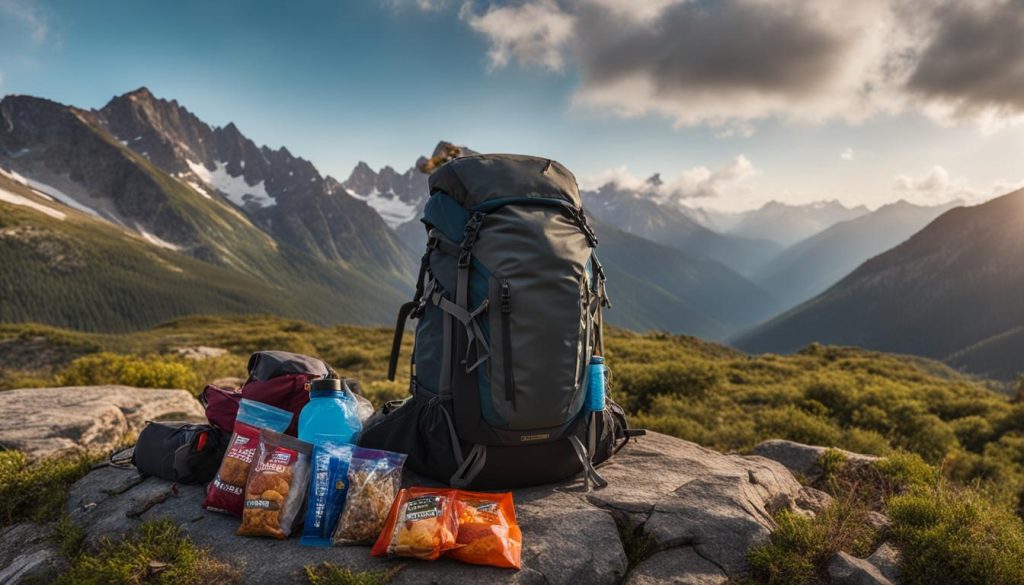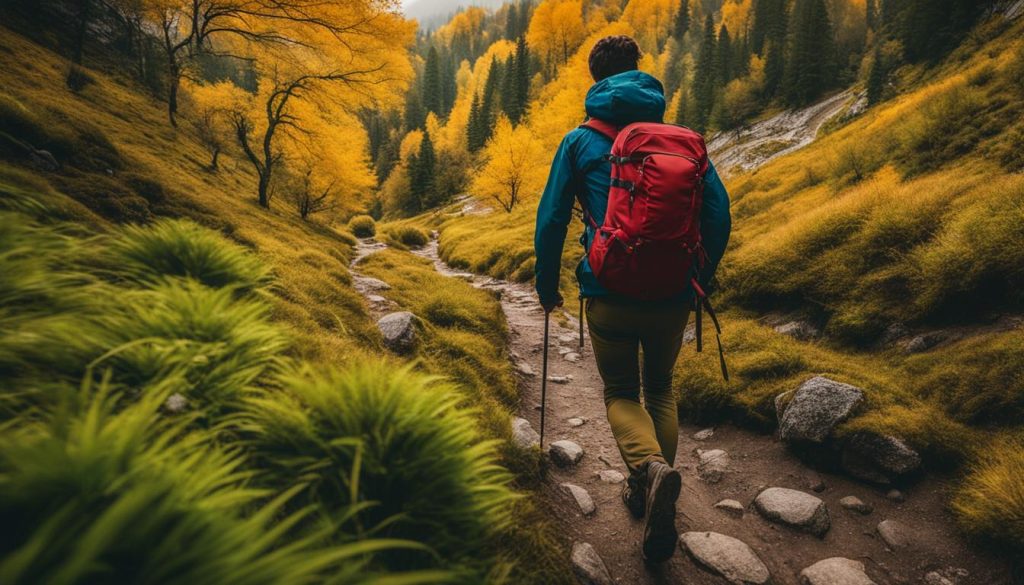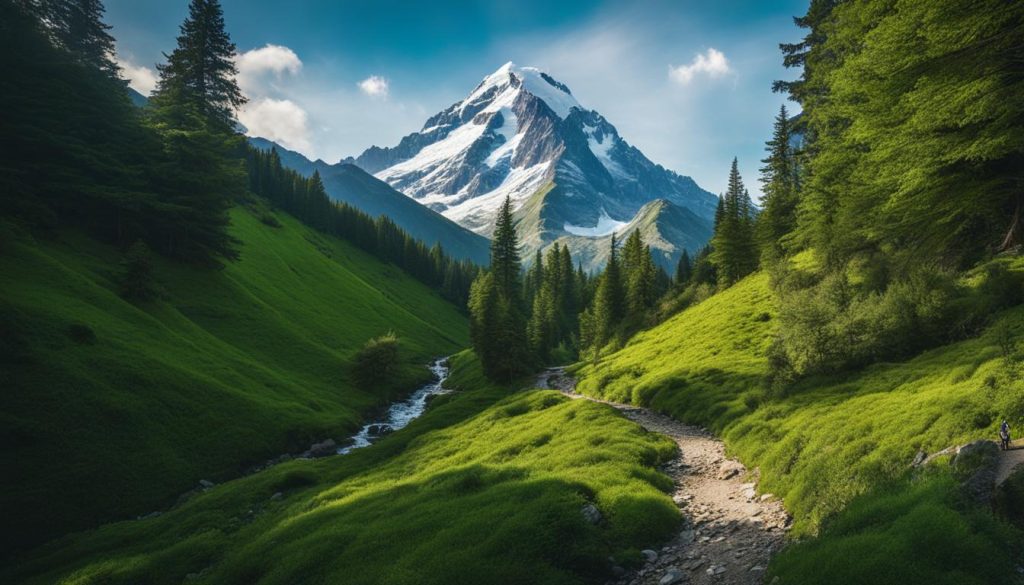Meal planning is crucial for a successful hiking trip. The food you choose should be lightweight, compact, and provide the necessary nutrition and energy for the adventure. There are various options to consider, such as dehydrated meals, DIY recipes, and fresh foods. It’s also important to stay hydrated and have warm beverages or soups during chilly trips. Alcohol should be consumed in moderation to avoid disrupting sleep.
Read: Hiking for People with Disabilities: How to Overcome Challenges and Enjoy the Trails
Key Takeaways
- Choose lightweight and compact foods for hiking
- Consider dehydrated meals, DIY recipes, and fresh foods
- Stay hydrated with warm beverages or soups
- Consume alcohol in moderation
- Meal planning is crucial for a successful hiking trip
Backpacking Breakfast Ideas
Starting your day with a nutritious breakfast is essential for fueling your hiking adventures. When it comes to backpacking breakfasts, you want something quick, easy, and lightweight. Here are some delicious ideas to kickstart your morning on the trail:
“Breakfast is everything. The beginning, the first thing. It is the mouthful that is the commitment to a new day, a continuing life.”
Instant Oatmeal
Instant oatmeal packets are a classic breakfast choice for backpackers. They are lightweight, compact, and require minimal preparation. Just add hot water, wait a few minutes, and enjoy a warm and filling breakfast. There are various flavors available, including options with added fruits and nuts for extra taste and energy.
Cereal and Granola
Cold cereals and granola are another convenient option for trail breakfasts. Choose lightweight and compact options that are easy to carry in your backpack. You can enjoy them with powdered milk or add them to a ziplock bag of yogurt or dried fruit for a more substantial meal.
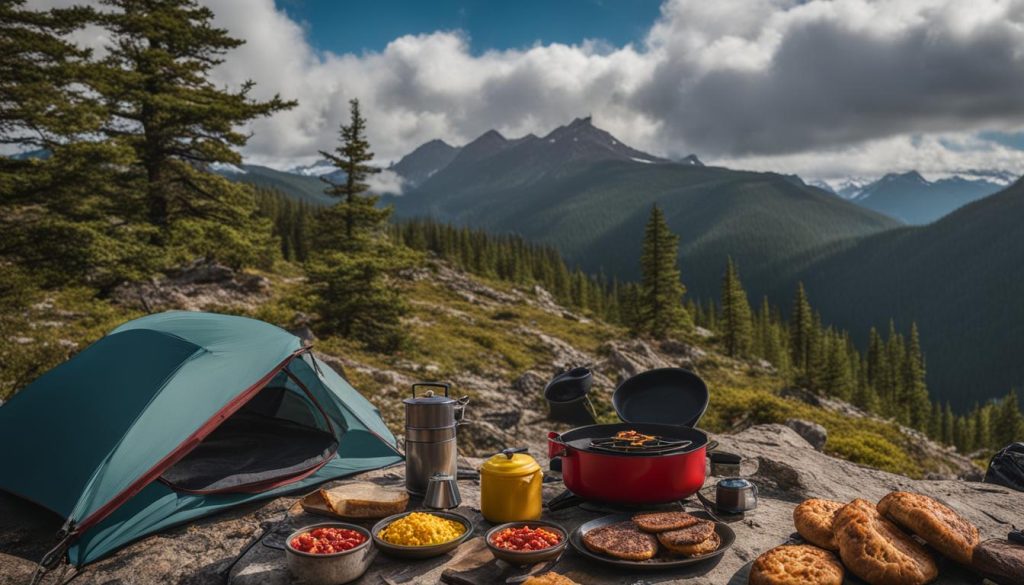
Muffins and Pastries
If you have a sweet tooth, consider packing some muffins or pastries for a quick and satisfying breakfast. Look for options that are individually wrapped to keep them fresh and protected during your hike. These treats can provide a burst of energy and make your mornings on the trail a little more enjoyable.
| Backpacking Breakfast Ideas | Preparation | Weight |
|---|---|---|
| Instant Oatmeal | Add hot water and wait | Lightweight |
| Cereal and Granola | Enjoy with powdered milk or mix with yogurt or dried fruit | Compact |
| Muffins and Pastries | Individually wrapped for freshness | Varies |
Remember to choose breakfast options that suit your taste preferences and dietary needs. Experiment with different combinations and find what works best for you. Fueling up with a hearty breakfast will provide the energy you need to conquer the trails ahead.
Lunch and Snack Ideas for the Trail
When you’re out hiking, it’s important to fuel your body with nutritious and portable snacks that will keep you energized throughout the day. Here are some lunch and snack ideas for the trail that are lightweight, flavorful, and easy to pack:
“The food you choose should be lightweight, compact, and provide the necessary nutrition and energy for the adventure.”
Lunch Options:
If you’re looking for something more substantial to keep you going until dinner, consider these lunch ideas:
- Tortillas or pita bread with various fillings such as peanut butter, hummus, or deli meats
- Smucker’s Uncrustables or frozen burritos for a quick and convenient meal
- No-cook meals like chicken or tuna packets that can be enjoyed straight from the pouch
- DIY cold soak meals, which involve soaking grains or noodles in water along with your favorite seasonings and vegetables
Trail Snack Ideas:
For on-the-go snacks that are easy to munch on while hiking, consider packing these options:
- Energy bars and cookies that are packed with nuts, seeds, and dried fruit
- Nut butter sachets or small containers for a quick protein boost
- Jerky or meat bars for a savory and protein-rich snack
- Trail mix with a mix of nuts, dried fruit, and even some chocolate for a sweet treat
- Candy or chocolate for a quick burst of energy
- Olives and cheese for a salty and satisfying snack
Remember to pack your snacks in resealable bags or lightweight containers to keep them fresh and easily accessible on the trail.
| Lunch Options | Trail Snack Ideas |
|---|---|
| Tortillas or pita bread with various fillings such as peanut butter, hummus, or deli meats | Energy bars and cookies packed with nuts, seeds, and dried fruit |
| Smucker’s Uncrustables or frozen burritos for a quick and convenient meal | Nut butter sachets or small containers for a quick protein boost |
| No-cook meals like chicken or tuna packets that can be enjoyed straight from the pouch | Jerky or meat bars for a savory and protein-rich snack |
| DIY cold soak meals with grains, noodles, seasonings, and vegetables | Trail mix with nuts, dried fruit, and chocolate |
By packing a combination of these lunch and snack options, you’ll have a variety of flavors and nutrients to keep you fueled and satisfied during your hiking adventures.
Backpacking Dinner Ideas
After a long day of hiking, a satisfying dinner can be just what you need to refuel and relax. When it comes to backpacking dinners, there are plenty of options available, including freeze-dried meals that are lightweight, convenient, and packed with nutrients. Whether you prefer a hearty pasta dish or a comforting soup, you can find a variety of freeze-dried backpacking meals that cater to your taste buds and dietary needs.
One popular brand for freeze-dried meals is Mountain House. They offer a wide range of dinner options, from classic favorites like beef stroganoff and lasagna to international dishes like chicken tikka masala and pad thai. These meals are quick and easy to prepare, requiring only hot water and a few minutes of rehydration. With their long shelf life, they are perfect for extended trips or emergency situations.
If you prefer to have more control over your dinner ingredients, you can also consider DIY dehydrated meals. By dehydrating your own favorite recipes, you can create personalized dinners that suit your taste and dietary restrictions. Some popular DIY dehydrated meal ideas include dehydrated chili, pasta with dried vegetables, and curry with dehydrated chicken.

Comparison of Freeze-Dried Backpacking Meals
| Brand | Meal Options | Weight | Calories |
|---|---|---|---|
| Mountain House | Beef Stroganoff, Lasagna, Chicken Teriyaki | 3.5-4.6 oz | 600-800 |
| Good To-Go | Thai Curry, Herbed Mushroom Risotto, Mexican Quinoa Bowl | 3.6-4.4 oz | 450-700 |
| MaryJanesFarm | West Coast Sausage Scramble, Santa Fe Black Beans and Rice | 3-3.5 oz | 270-580 |
| PackIt Gourmet | Red Beans and Rice, Cuban Coconut Rice, Texas State Fair Chili | 3.8-4.8 oz | 500-800 |
When selecting freeze-dried backpacking meals, consider factors such as weight, calorie content, and flavor options. It’s also a good idea to try different brands and flavors before your trip to find the ones that best suit your taste buds. With a variety of options available, you can enjoy delicious and nutritious dinners on your backpacking adventures.
Trail Snacks and Bars
When you’re out on the trail, having the right snacks and energy bars can make all the difference in keeping you fueled and energized. Portable and easy-to-carry options are essential, so you can enjoy a quick bite whenever you need a boost. From bars packed with protein and nutrients to a variety of trail mix options, there is something for everyone’s taste and dietary preferences.
Trail Snacks
- Trail mix: A classic choice, trail mix is a blend of nuts, dried fruits, and sometimes chocolate or other sweet treats. It provides a good balance of protein, healthy fats, and carbohydrates to keep you going.
- Jerky: Whether it’s beef, turkey, or even plant-based, jerky is a great source of protein and a savory snack option.
- Dried fruit: Lightweight and packed with natural sugars, dried fruit is a tasty and energizing snack.
- Energy gummies: These bite-sized treats are designed to give you a quick burst of energy and are often fortified with vitamins and electrolytes.
- Crackers: Individual packs of crackers are a convenient and crunchy snack option to enjoy on the trail.
Portable Energy Bars
Energy bars are a go-to option for many hikers due to their convenience and nutritional value. They come in a wide variety of flavors and formulations, catering to different dietary needs and preferences. Some popular energy bar brands include Larabar, Clif Bar, ProBar, Ivan Bar, Luna, Kind, and Bobo’s. These bars are often made with wholesome ingredients like nuts, seeds, dried fruits, and grains, providing a mix of carbohydrates, healthy fats, and protein to sustain your energy levels.
It’s important to find snacks and energy bars that you enjoy eating and that provide the nutrients and energy you need for your hiking adventures. Consider your dietary preferences, any food allergies or restrictions, and aim for a good balance of macronutrients to keep you satisfied and fueled throughout your journey.
Table: Comparison of Energy Bars
| Larabar | Clif Bar | ProBar | Ivan Bar | |
|---|---|---|---|---|
| Taste | Naturally sweet and fruity | Variety of flavors, including chocolate | Rich and diverse flavors | Nutty and chocolatey |
| Ingredients | Few simple ingredients, like nuts and dried fruit | Mixture of oats, nuts, and other ingredients | Wide variety, including fruits, nuts, and seeds | Nuts, dates, and chocolate |
| Protein Content | Low to moderate | Moderate to high | High | Moderate |
| Allergen-friendly | Many flavors are gluten-free, dairy-free, and vegan | Some flavors are gluten-free and vegan | Many bars are gluten-free, vegan, and organic | Many flavors are gluten-free, dairy-free, and vegan |

Remember to pack your trail snacks and energy bars in easy-to-access pockets of your backpack, so you can enjoy them throughout the day without having to stop for a long break. Snacking regularly can help maintain your energy levels and keep you going strong on the trail. Experiment with different flavors and combinations to find your favorite hiking snacks that will keep you motivated and fueled on your outdoor adventures.
Camp Kitchen Essentials
When it comes to backpacking, having the right cooking equipment is essential for a successful trip. The right gear can make meal preparation easier and more enjoyable, allowing you to fuel up and recharge after a long day on the trail. Here are some camp kitchen essentials to consider:
Stove System
A reliable stove system is a must-have for backpacking. Some popular options include the JetBoil MiniMo, MSR Pocket Rocket 2, and BRS Stove. These compact and lightweight stoves are designed to efficiently heat up water and cook meals, making them perfect for backpacking adventures.
Cookpots
Having a lightweight and durable cookpot is essential for boiling water and cooking meals. The Snow Peak Mini Solo Cookset and MSR Big Titan Kettle are popular choices among backpackers. These cookpots are designed to be compact and efficient, allowing you to cook your meals with ease.
Spoon and Cup
Don’t forget to pack a long spoon, such as the Sea to Summit Alpha Light Long Spoon, for easy eating. Additionally, having a lightweight cup, like the Snow Peak Titanium Single 450, is useful for enjoying hot beverages or soups during your trip.
Food Storage
Proper food storage is important to keep your supplies safe and secure. Consider using an Ursack or BearVault BV500, which are bear-resistant containers designed to keep wildlife away from your food. These containers are essential for backcountry trips where bears and other animals may be present.
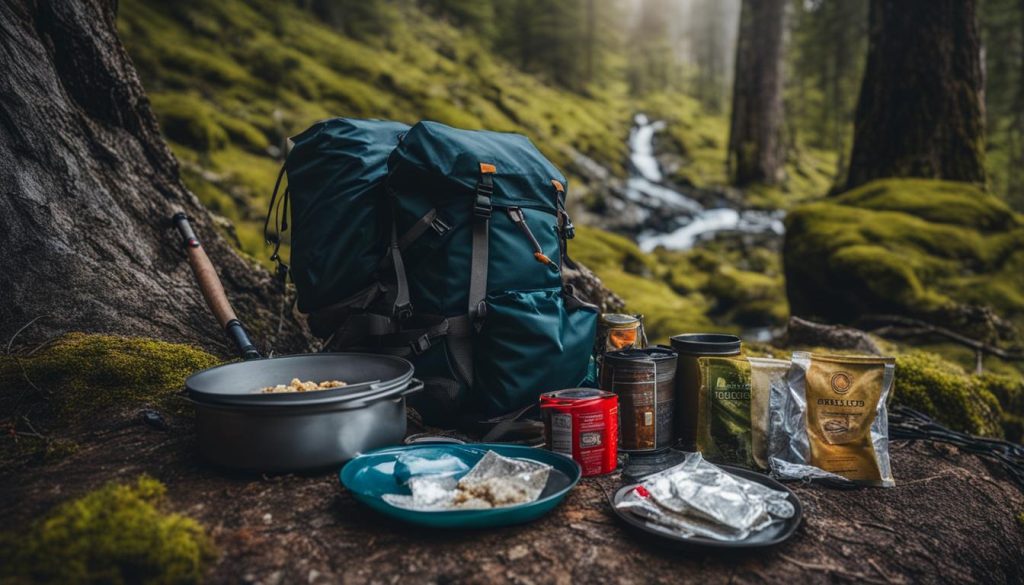
Conclusion
Having the right camp kitchen essentials can greatly enhance your backpacking experience. Whether you’re enjoying a hot meal after a long hike or sipping on a warm cup of coffee in the morning, the right gear makes all the difference. Remember to choose lightweight and compact options that fit your needs and preferences. With the right cooking equipment, you’ll be well-prepared to enjoy delicious meals and make lasting memories on your backpacking trip.
There are important principles to follow when it comes to food storage in the backcountry. It’s essential to adhere to Leave No Trace principles to protect wildlife and preserve the natural environment. This includes proper food storage to prevent wildlife encounters. One recommended method is using bear canisters, which are designed to keep food secure and inaccessible to animals. Bear canisters come in various sizes and are made of sturdy materials that withstand the strength and persistence of bears. They provide peace of mind and help ensure the safety of both humans and wildlife.
Additionally, repackaging food in Ziploc bags is a practical way to reduce waste and save space in your backpack. By removing excess packaging and transferring food into resealable bags, you can minimize the amount of trash you carry. It’s also a good idea to carry small packets of spices and condiments instead of bulky containers to avoid unnecessary waste. These small changes can make a big difference in reducing your environmental impact while on the trail.
When it comes to food options, it’s important to choose lightweight, compact, and nutritious meals that are easy to prepare and consume. Dehydrated meals, freeze-dried backpacking meals, and DIY dehydrated meals are popular choices among hikers. These meals are lightweight and require minimal preparation, making them ideal for backpacking trips. It’s also important to pack foods that are high in calories to fuel your body for the physical demands of hiking.
To summarize, following Leave No Trace principles and properly storing food in bear canisters or repackaging them in Ziploc bags are important steps to protect wildlife and minimize waste. When selecting food options, prioritize lightweight, nutritious meals that are easy to prepare and consume. By considering these factors, you can have a positive impact on the environment while enjoying your outdoor adventures.
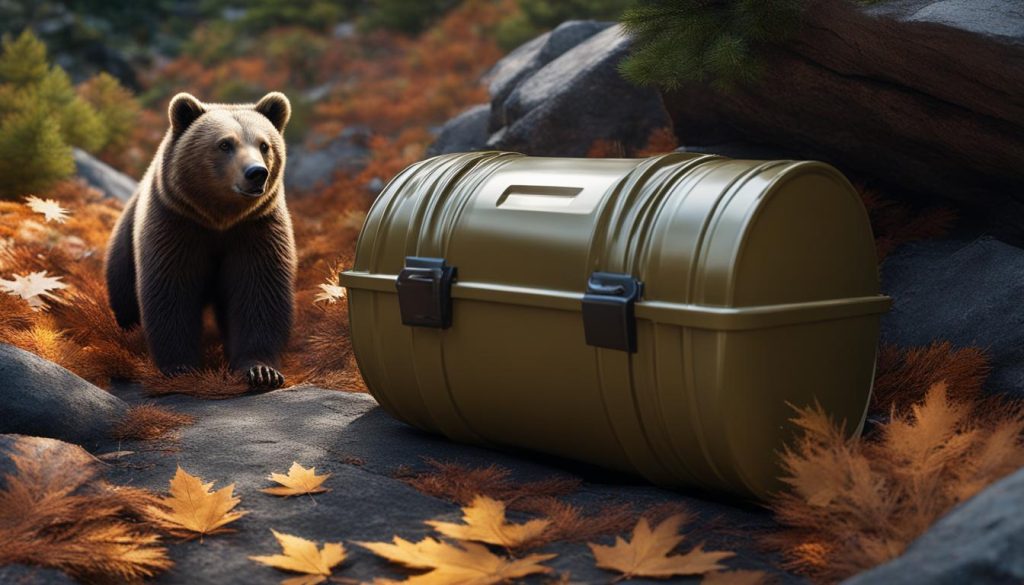
Calorie Intake and Nutritional Considerations
When embarking on a backpacking adventure, it’s important to consider your calorie intake and nutritional needs. Hiking can be physically demanding, and your body requires fuel to keep going. On average, hikers burn between 3000-4000 calories per day, but for thru-hikers, that number can easily reach 5000-6000 calories. It’s crucial to consume enough calories to replenish your energy levels and support muscle repair.
While it may be tempting to rely on high-calorie junk foods, it’s essential to prioritize balanced nutrition. Aim for a variety of whole foods that provide a mix of carbohydrates, protein, and healthy fats. Carbohydrates will supply the energy you need for hiking, protein will aid in muscle recovery, and fats will provide sustained energy throughout the day.
“Proper nutrition is crucial for maintaining stamina and preventing fatigue on the trail. A well-balanced diet will not only fuel your body but also help you recover faster after long days of hiking.”
Staying hydrated is equally important when hiking. Remember to drink plenty of water throughout the day, especially in hot or high-altitude environments. Carry a water filter or purification tablets to ensure access to clean drinking water along the trail.
Sample Table: Calorie Intake and Nutritional Considerations
| Meal | Calories | Key Nutrients |
|---|---|---|
| Breakfast | 500-800 calories | Carbohydrates, Protein, Healthy Fats |
| Lunch | 600-900 calories | Carbohydrates, Protein, Healthy Fats |
| Snacks | 200-400 calories (per snack) | Carbohydrates, Protein, Healthy Fats |
| Dinner | 700-1000 calories | Carbohydrates, Protein, Healthy Fats |
| Hydration | Drink at least 2-4 liters of water per day | N/A |
Remember to consult with a healthcare professional or registered dietitian for personalized nutrition advice. They can help you determine the specific calorie requirements and recommend foods that suit your dietary preferences and restrictions. Prioritize your nutrition to ensure a successful and enjoyable backpacking experience.
Resupply Considerations
When embarking on a long-distance hiking adventure, resupplying food along the way becomes a crucial consideration. You need to ensure that the food you choose can withstand being packed for several days without refrigeration, and that it is readily available in trail towns. Planning your resupply strategy strategically can make a significant difference in the success and enjoyment of your trip.
There are several popular options for resupplying your food during a long-distance hike. One common choice is instant oatmeal, which is lightweight, easy to prepare, and provides a quick and nutritious breakfast option. Tortillas are another versatile food item that can be used for sandwiches or as a base for various fillings, and they can withstand being packed for several days without spoiling. Jerky and cheese are excellent sources of protein that can be enjoyed as a snack or added to meals, while powdered drink mixes can help replenish electrolytes and keep you hydrated.
Grocery Store Resupply
One option for resupplying food is to rely on grocery stores located in trail towns. These stores often carry a wide range of backpacking-friendly foods, such as dehydrated meals, instant soups, pasta sides, and other lightweight options. Additionally, you can find fresh produce, bread, and other perishable items to add variety to your diet. It’s a good idea to research the trail towns along your route and make note of the grocery stores available so you can plan your resupply accordingly.
Mail Drops
For those with specific dietary needs or preferences, planning mail drops can be a useful strategy. This involves sending packages of food ahead to predetermined locations along your route. This allows you to have access to specialty items that may not be available at local grocery stores. Some hikers choose to send packages with homemade dehydrated meals, personalized snack mixes, and treats to enjoy on the trail. However, it’s important to consider the logistics and timing of your mail drops to ensure that your packages arrive on time and in good condition.
Trail Angel Support
Another option to consider is relying on the kindness of trail angels. Trail angels are individuals or organizations who offer support to hikers by providing rides, showers, meals, and sometimes even resupply items. They can be found along popular long-distance trails and are often willing to assist hikers with their resupply needs. Establishing connections with trail angels through hiking forums or online communities can be beneficial in securing resupply support along your route.
| Resupply Option | Advantages | Disadvantages |
|---|---|---|
| Grocery Store Resupply | – Wide variety of food options – Easy access to fresh produce – Can be cost-effective |
– Limited availability in remote trail towns – Dependence on store hours and stock |
| Mail Drops | – Ability to customize food choices – Access to specialty items – Peace of mind for specific dietary needs |
– Requires careful planning and organization – Additional cost for shipping packages – Potential delays or lost packages |
| Trail Angel Support | – Personalized assistance and support – Potential for unexpected surprises or treats – Builds connections with the hiking community |
– Reliance on availability and generosity of trail angels – Limited access in less-populated areas – Requires prior research and coordination |
Ultimately, the best resupply strategy will depend on your individual needs, preferences, and the specific demands of your hiking trip. It can be helpful to combine different resupply options throughout your journey to ensure a varied and enjoyable food experience. Remember to plan ahead, research trail towns, and consider the logistics of your resupply strategy to make your long-distance hiking trip a success.
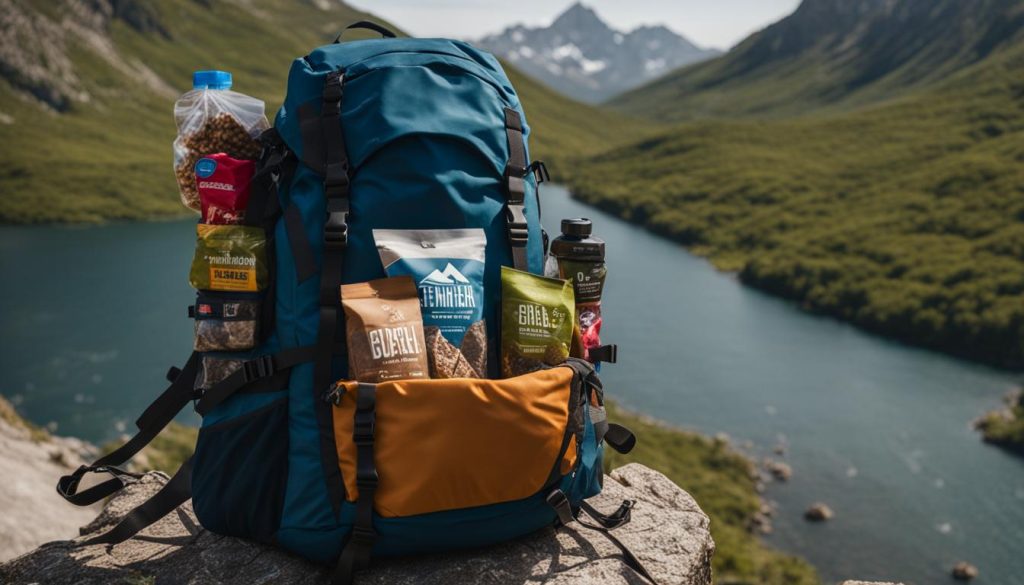
Backpacking Food List
When planning for a backpacking trip, having a comprehensive food list is essential to ensure you have enough nourishment to sustain you throughout your journey. Below is a selection of backpacking food items categorized by meal type, offering you a variety of options to choose from:
Breakfast:
- Instant oatmeal
- Cold cereal
- Granola
- Chia seeds
- Pop tarts
- Honey buns
Lunch and Snacks:
- Tortillas
- Pita bread
- Bagels
- Smucker’s Uncrustables
- Frozen burritos
- Energy bars and cookies
Dinner:
- Freeze-dried meal pouches (Mountain House, MaryJanesFarm, etc.)
- Instant mashed potatoes
- Ramen
- Instant soups
- Pasta and rice sides
- Dehydrated vegetables
Dessert:
- Chocolate bars
- Dehydrated fruit
- Trail mix with nuts and dried fruit
- Instant pudding
- Marshmallows for roasting
- Graham crackers
Remember to choose food items that are lightweight, easy to prepare, and provide you with the necessary energy for your backpacking adventure. Don’t forget to consider your personal preferences and dietary needs when selecting your backpacking food list.
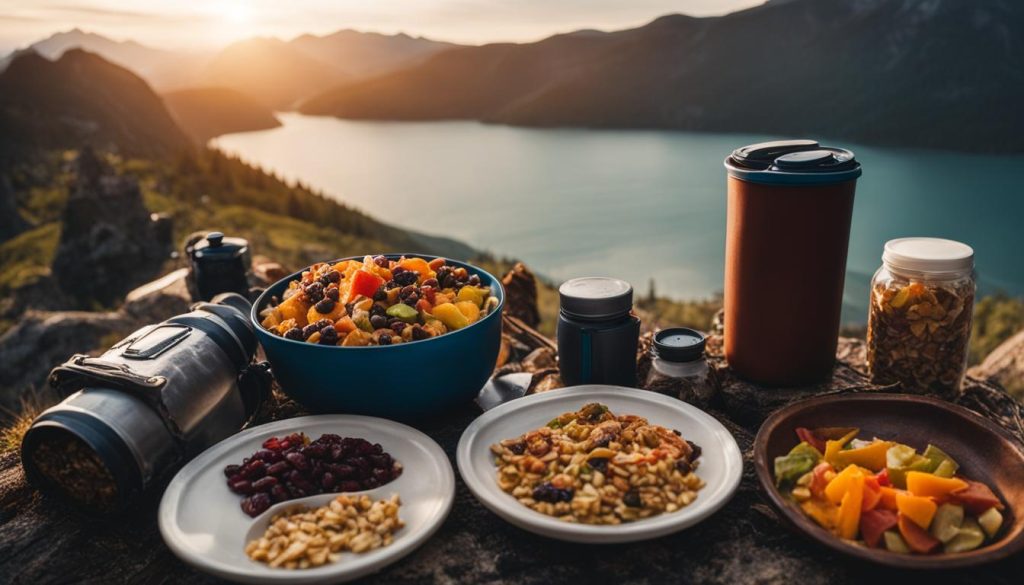
Tips for Backpacking Food Storage and Preparation
Proper food storage and preparation are essential for a successful backpacking trip. Whether you’re a seasoned hiker or a beginner, following these tips will help ensure that your food stays fresh, delicious, and safe to consume throughout your adventure.
1. Repackage Your Food
When packing food for your backpacking trip, it’s important to remove unnecessary packaging and repackage your meals and snacks in Ziploc bags or lightweight containers. This not only saves space but also reduces waste and helps keep your backpack organized. Be sure to label each bag with the contents and cooking instructions, if applicable.
2. Use Spices and Condiments
Enhance the flavor of your backpacking meals by bringing along small packets of spices and condiments. Salt, pepper, garlic powder, and hot sauce can add a burst of flavor to even the simplest of dishes. Consider bringing single-serve packets of ketchup, mustard, or soy sauce to elevate your meals and make them more enjoyable.
3. Avoid Canned Foods
While canned foods may seem convenient, they can be heavy and take up valuable space in your backpack. Opt for lightweight and compact alternatives instead. Dehydrated meals, freeze-dried options, and dry goods like instant rice or pasta are excellent choices that provide the necessary nutrients without the added weight.
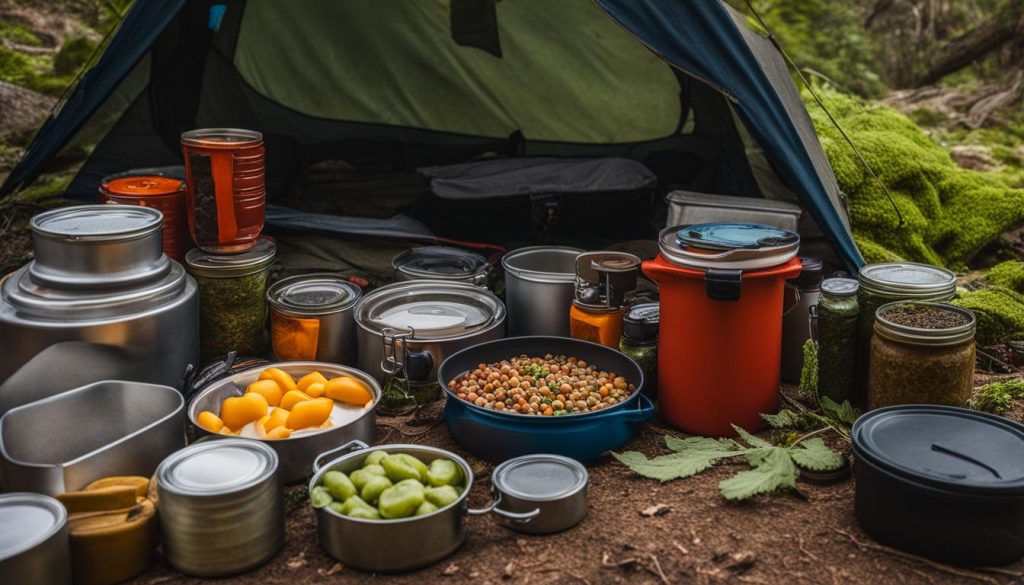
4. Consider DIY Dehydrating
If you’re looking to save money and have more control over your meals, consider DIY dehydrating. This process involves drying your own fruits, vegetables, and meats using a dehydrator or an oven. Not only does this allow you to customize your meals, but it also reduces the weight and volume of your food, making it easier to pack and carry.
By following these tips for backpacking food storage and preparation, you can ensure that your meals are tasty, easy to prepare, and safe for consumption. Remember to pack out all trash, dispose of it properly, and respect the Leave No Trace principles to keep the wilderness pristine for future hikers.
Conclusion
As you conclude your journey into the world of hiking food ideas, it’s important to remember the key takeaways. Meal planning is essential for a successful hiking trip, and choosing lightweight and compact options will ensure you have the necessary nutrition and energy. From backpacking breakfast ideas to trail snacks and bars, there are plenty of delicious and portable options to fuel your adventures.
When it comes to backpacking dinners, freeze-dried meal pouches and instant options are convenient and satisfying. And don’t forget about the importance of proper cooking equipment and food storage to ensure a smooth and enjoyable trip. Following Leave No Trace principles and using bear canisters or food storage options will help protect wildlife and maintain the beauty of nature.
To meet the demands of long-distance hikes, resupply considerations are crucial. Opt for foods that can withstand being packed for several days without refrigeration and are readily available in trail towns. Lastly, remember to consume enough calories to fuel your body, stay hydrated, and consider taking a daily multivitamin to support your nutritional needs.
Now armed with a comprehensive backpacking food list and tips for storage and preparation, you’re well-equipped to embark on your hiking adventures. So go out, explore the trails, and enjoy the experience to the fullest with the right balance of lightweight, nutritious, and delicious food.
FAQ
What are some lightweight breakfast options for backpacking?
Some lightweight breakfast options for backpacking include instant oatmeal, cold cereal, granola, chia seeds, pop tarts, honey buns, muffins, freeze-dried breakfasts, DIY yogurt parfait, dehydrated quinoa porridge, instant coffee, and tea.
What are some portable lunch and snack options for the trail?
Portable lunch and snack options for the trail include tortillas, pita bread, bagels, Smucker’s Uncrustables, frozen burritos, crusty bread, Greenbelly meal bars, no-cook meals, DIY cold soak meals, chicken/tuna/SPAM packets, packaroons, energy bars and cookies, nut butter, jerky and meat bars, trail mix, dried fruit, candy, olives, and cheese.
What are some dinner options for backpacking?
Some dinner options for backpacking include freeze-dried meal pouches like Mountain House, MaryJanesFarm, Good To-Go, PackIt Gourmet, PEAK Refuel, instant mashed potatoes, ramen, instant soups, stuffing, instant mac & cheese, pasta, rice sides, couscous, chicken/tuna packets, dried pork packets, dehydrated vegetables, and DIY dehydrated meals.
What are some popular trail snacks and bars?
Popular trail snacks and bars include Larabar, Clif Bar, ProBar, Ivan Bar, Luna, Kind, Bobo’s bars, trail mix, nuts and seeds, dried fruit, fruit leather strips, jerky, crackers, candy, energy gummies, Quinn peanut butter-filled pretzels, Oloves olives, cheese, and homemade beef jerky.
What cooking equipment should I bring for backpacking?
Recommended cooking equipment for backpacking includes a stove system such as JetBoil MiniMo, MSR Pocket Rocket 2 & BRS Stove, cookpots like Snow Peak Mini Solo Cookset, MSR Big Titan Kettle, a spoon like Sea to Summit Alpha Light Long Spoon, a cup like Snow Peak Titanium Single 450, and food storage options like Ursack & BearVault BV500.
How should I store and prepare my backpacking food?
It’s important to follow Leave No Trace principles and properly store food to protect wildlife. This includes packing out all trash, repackaging food in Ziploc bags, carrying small packets of spices and condiments to avoid waste, avoiding canned foods, and using proper food storage options like Ursack or Bear Canisters to prevent wildlife encounters.
How many calories should I consume while backpacking?
On average, hikers burn between 3000-4000 calories per day, but thru-hikers can easily burn 5000-6000 calories. It’s important to consume enough calories to fuel your body. Balanced nutrition and variety are crucial, considering factors like protein for muscle repair. Staying hydrated and taking a daily multivitamin are also important considerations.
What are some considerations for resupplying food on long-distance hikes?
Foods that can withstand being packed for several days without refrigeration and are readily available in trail towns are ideal for resupplying. Popular options include instant oatmeal, tortillas, jerky, cheese, and powdered drink mixes. Planning mail drops with specialty items can also be considered for more specific dietary needs.
Can you provide a list of backpacking food items?
Sure! Here is a list of backpacking food items categorized by meal type, including breakfast, lunch/snacks, dinner, and dessert. The list includes items such as instant oatmeal, cold cereal, powders, bars, bread options, freeze-dried meals, and various drink mixes.
What are some tips for storing and preparing backpacking food?
Tips for storing and preparing backpacking food include repackaging food in Ziploc bags, using spices and condiments to enhance meals, avoiding canned foods, and utilizing DIY dehydrating options. It’s important to follow proper food storage techniques and consider using bear canisters or other backcountry food storage methods to protect wildlife.

